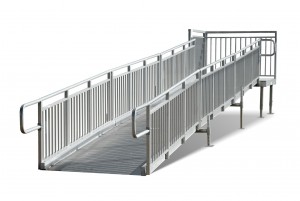Are you looking to set up a modern hospital in your local area? One of your goals is probably to create a memorable experience by providing services that will leave patients talking positively about your establishment. Although this might sound like an easy task, a lot goes into starting a hospital. You must factor in the general wellness of your target audience, including their safety and mobility within the facility.
 States throughout the U.S. provide standards for designing and constructing wheelchair access ramps and other accessibility features. It is essential to install IDA and ADA-compliant wheelchair access ramps in your facility to ease patient and staff movement. It also ensures that your facility complies with your state’s regulations and standards.
States throughout the U.S. provide standards for designing and constructing wheelchair access ramps and other accessibility features. It is essential to install IDA and ADA-compliant wheelchair access ramps in your facility to ease patient and staff movement. It also ensures that your facility complies with your state’s regulations and standards.
REDD Team is a premier designer and manufacturer of quality access products for industrial, commercial, military, and school facilities throughout the U.S. All our products are compliant and designed to meet states’ building codes. User safety is of utmost importance when designing and manufacturing access products.
Designing the Ramp
The first step in ensuring user safety in your facility is to install access products that comply with OSHA, ADA, and IBC guidelines. The ramp design should be based on the intended use, location, and level of accessibility required. The ramp should accommodate wheelchairs and mobility devices, with a minimum width of 36 inches. The slope of the ramp should be no steeper than 1:12, and there should be a landing at the top and bottom of the ramp. Remember to install handrails on both sides of the ramp, with a height between 34 and 38 inches.
Installation of the Ramp
Once the design is complete, the ramp must be installed correctly to ensure user safety. The ramp should securely anchor the ground with excellent support and bracing. The surface of the ramp should be slip-resistant and free from any obstructions or tripping hazards. If the ramp is more than 30 inches high, a curb or barrier must be installed to prevent users from falling off the side of the ramp.
Maintenance of the Ramp
Regular maintenance of the ramp is essential to user safety. The ramp should be inspected regularly for damages, including wear and tear and other issues affecting user safety. Any problems should be repaired immediately to prevent accidents or injuries. The surface of the ramp should also be kept clean and free from debris, snow, or ice.
Training for Users
Ramp users should receive proper training on how to navigate the ramp safely. This includes teaching users how to use handrails properly, approach and exit the ramp, and safely maneuver their wheelchair or mobility device. Training should also include information on recognizing and avoiding hazards such as loose gravel, wet or slippery surfaces, or uneven terrain.
Accessibility for All Users
To ensure every user’s safety, the ramp should be designed and installed with accessibility in mind. This ensures the ramp is wide enough to accommodate different mobility devices, including power chairs and scooters. The ramp should also be designed to be easily navigable by users with visual impairments or other disabilities.
Emergency Preparedness
In an emergency, ramp users must be able to evacuate quickly and safely. This means ensuring that the ramp is designed to be accessible to emergency responders and that users are trained on emergency procedures. Additionally, the ramp should be located in a visible and accessible location, with clear signage and lighting.
REDD Team has been designing and manufacturing access products for many years. We have supplied many facilities throughout the U.S. with compliant access products.
Please call REDD Team today for IBC and ADA-compliant wheelchair access ramps.

